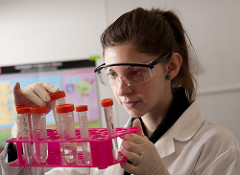Because of a lapse in government funding, the information on this website may not be up to date, transactions submitted via the
website may not be processed, and the agency may not be able to respond to inquiries until appropriations are enacted. The NIH
Clinical Center (the research hospital of NIH) is open. For more details about its operating status, please visit
cc.nih.gov.
Updates regarding government operating status and resumption of normal operations can be found at
opm.gov.
Safety
Chemical Monitoring
Page Content

From the laboratory to the operating room and everywhere in between, chemicals are used extensively by the NIH community. With numerous chemicals available offering a wide variety of useful properties, chemicals have become ubiquitous in all operations directly implementing or supporting the agency's mission.
Many chemicals can be harmful to human health, and must be handled and used in a safe and careful manner. The NIH Division of Occupational Health and Safety (DOHS) has developed a series of chemical monitoring programs to protect the NIH community through vigilant surveillance.
The programs below incorporate regularly scheduled monitoring. As such, employees may request additional monitoring for additional chemicals not listed within the below programs or to assess chemical exposure during specific operations and/or times that differ from planned monitoring. Additional support is available for vulnerable workers such as those with respiratory illnesses, immune system suppression, or pregnancy.
Dichloromethane/methylene chloride Program
 EPA Guide to Compliance with DCM Ruling
EPA Guide to Compliance with DCM Ruling

The DOHS Technical Assistance Branch (TAB) manages the above listed chemical monitoring programs and has extensive in-house capabilities to assess workplace chemical exposures at NIH. If monitoring indicates a need to reduce chemical exposure, TAB will advise your organization to make the work environment safer following the  hierarchy of controls.
hierarchy of controls.
Questions about Chemical Monitoring?
Contact DOHS, TAB at (301) 496-3353.
back to the top
